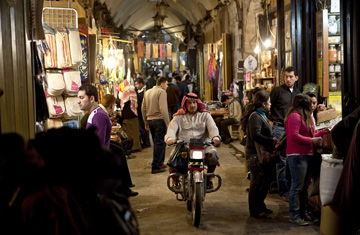
Ride through time Stretching for several kilometers, Aleppo's ancient suq offers a trip into the city's past
In distant times, it flourished as one of the western extremities of the ancient Silk Road before being ransacked by Mongols and devastated by earthquakes. These days, however, the northern Syrian city of Aleppo is acquiring a renewed appreciation of its monumental past, sprucing up its historic Citadel and medina with the help of the Aga Khan Trust for Culture. Other aspects of this ancient city's allure — like the heady mix of cultures from Kurdish to Armenian and Circassian — have never changed. Here are five Aleppo essentials.
1 The Suq
Aleppo has the longest covered suq in the Middle East, a teeming stretch of alleyways connecting mosques, inns and hammams. To wander through this clamorous labyrinth is to tread back in time, as you weave between donkey-hauled carts, coppersmiths at work and perfumers mixing vials of heady fragrance. You can easily lose yourself for an entire day, but don't leave without buying a bar of the famous Aleppo soap, handmade from olive and bay-leaf oils. Vendors abound throughout the suq.
2 The Citadel
Towering over the old town, the Citadel is one of the medieval wonders of the Levant, as the countries of the eastern Mediterranean used to be called. Set on a natural mound and reached by a vast arched bridge, the castle's streets, mosques, palace and baths form a city within a city: a refuge for Aleppans in times of past danger. Until recently a traffic-choked road ran around the mound; now the Citadel's moat and ramparts have been cleaned, and the ring road replaced with a boulevard lined with pavement cafés.
3 Basilica of St. Simeon Stylites
Christians believe that the 5th century mystic St. Simeon lived for 39 years atop a stone column on a hill near Aleppo, attracting devotees from around the Christian world. When he died, four Byzantine-style basilicas were built at the site to accommodate pilgrims. These now lie in picturesque ruins, overgrown with local pines, though you can still see the remains of Simeon's column and enjoy sweeping views over the surrounding country. Take a taxi from Aleppo — the ride lasts for around an hour — and top off your visit with a glass of freshly squeezed pomegranate juice at the nearby café.
4 Whirling Dervishes
Aleppo's dervishes belong to the mystical Sufi sect of Islam, which originated in Turkey. Dressed in long, flowing skirts and conical hats, and accompanied by chanting and the strains of an oud, or Arabic lute, dervishes use a characteristic whirling dance to enter an altered state and so, they hope, a closer communion with the divine. You can see dervish performances at the restored (but not operational) 14th century psychiatric hospital of Bimaristan Arghan (itself worthy of a visit), or in restaurants like those at the Dar Zamaria hotel, tel: (963-21) 363 6100.
5 The Bar of the Baron Hotel
It was once possible to shoot game from the terrace of the Baron Hotel, tel: (963-21) 211 0880. These days, however, this 1909 grande dame is surrounded by Aleppo's suburbs. But step inside and it seems as though nothing has changed since the days when Agatha Christie, Charles Lindbergh and Theodore Roosevelt stayed there. Admire Lawrence of Arabia's unpaid bill and the old Orient Express posters, then sink into a sagging leather armchair and order an old-fashioned cocktail.
Got an awful travel gripe? The Avenger may be able to sort it out for you.
